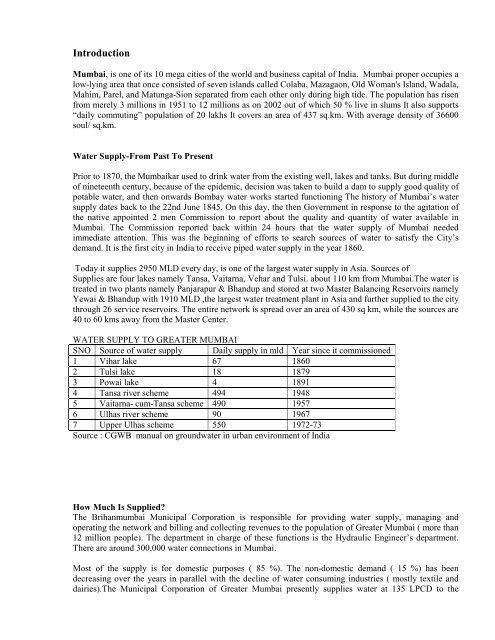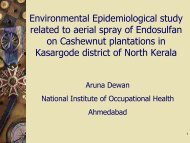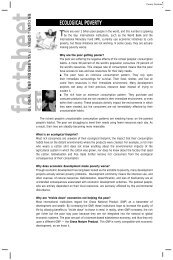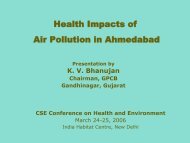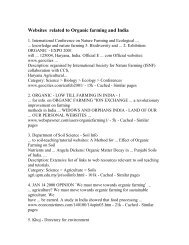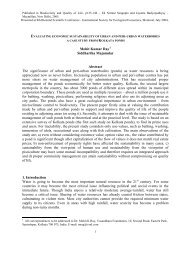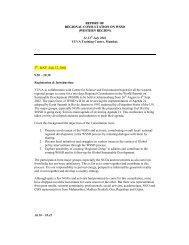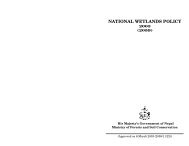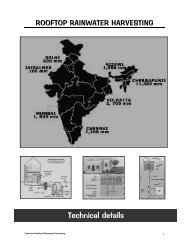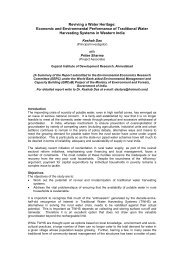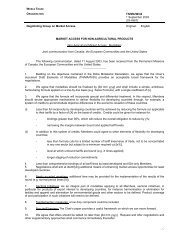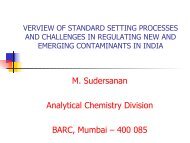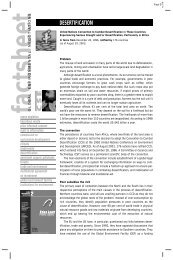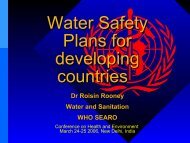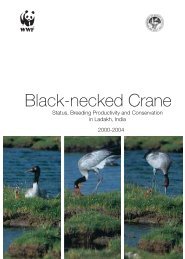Water supply in Mumbai - Rainwater Harvesting
Water supply in Mumbai - Rainwater Harvesting
Water supply in Mumbai - Rainwater Harvesting
Create successful ePaper yourself
Turn your PDF publications into a flip-book with our unique Google optimized e-Paper software.
Introduction<strong>Mumbai</strong>, is one of its 10 mega cities of the world and bus<strong>in</strong>ess capital of India. <strong>Mumbai</strong> proper occupies alow-ly<strong>in</strong>g area that once consisted of seven islands called Colaba, Mazagaon, Old Woman's Island, Wadala,Mahim, Parel, and Matunga-Sion separated from each other only dur<strong>in</strong>g high tide. The population has risenfrom merely 3 millions <strong>in</strong> 1951 to 12 millions as on 2002 out of which 50 % live <strong>in</strong> slums It also supports“daily commut<strong>in</strong>g” population of 20 lakhs It covers an area of 437 sq.km. With average density of 36600soul/ sq.km.<strong>Water</strong> Supply-From Past To PresentPrior to 1870, the <strong>Mumbai</strong>kar used to dr<strong>in</strong>k water from the exist<strong>in</strong>g well, lakes and tanks. But dur<strong>in</strong>g middleof n<strong>in</strong>eteenth century, because of the epidemic, decision was taken to build a dam to <strong>supply</strong> good quality ofpotable water, and then onwards Bombay water works started function<strong>in</strong>g The history of <strong>Mumbai</strong>’s water<strong>supply</strong> dates back to the 22nd June 1845. On this day, the then Government <strong>in</strong> response to the agitation ofthe native appo<strong>in</strong>ted 2 men Commission to report about the quality and quantity of water available <strong>in</strong><strong>Mumbai</strong>. The Commission reported back with<strong>in</strong> 24 hours that the water <strong>supply</strong> of <strong>Mumbai</strong> neededimmediate attention. This was the beg<strong>in</strong>n<strong>in</strong>g of efforts to search sources of water to satisfy the City’sdemand. It is the first city <strong>in</strong> India to receive piped water <strong>supply</strong> <strong>in</strong> the year 1860.Today it supplies 2950 MLD every day, is one of the largest water <strong>supply</strong> <strong>in</strong> Asia. Sources ofSupplies are four lakes namely Tansa, Vaitarna, Vehar and Tulsi. about 110 km from <strong>Mumbai</strong>.The water istreated <strong>in</strong> two plants namely Panjarapur & Bhandup and stored at two Master Balanc<strong>in</strong>g Reservoirs namelyYewai & Bhandup with 1910 MLD ,the largest water treatment plant <strong>in</strong> Asia and further supplied to the citythrough 26 service reservoirs. The entire network is spread over an area of 430 sq km, while the sources are40 to 60 kms away from the Master Center.WATER SUPPLY TO GREATER MUMBAISNO Source of water <strong>supply</strong> Daily <strong>supply</strong> <strong>in</strong> mld Year s<strong>in</strong>ce it commissioned1 Vihar lake 67 18602 Tulsi lake 18 18793 Powai lake 4 18914 Tansa river scheme 494 19485 Vaitarna- cum-Tansa scheme 490 19576 Ulhas river scheme 90 19677 Upper Ulhas scheme 550 1972-73Source : CGWB manual on groundwater <strong>in</strong> urban environment of IndiaHow Much Is Supplied?The Brihanmumbai Municipal Corporation is responsible for provid<strong>in</strong>g water <strong>supply</strong>, manag<strong>in</strong>g andoperat<strong>in</strong>g the network and bill<strong>in</strong>g and collect<strong>in</strong>g revenues to the population of Greater <strong>Mumbai</strong> ( more than12 million people). The department <strong>in</strong> charge of these functions is the Hydraulic Eng<strong>in</strong>eer’s department.There are around 300,000 water connections <strong>in</strong> <strong>Mumbai</strong>.Most of the <strong>supply</strong> is for domestic purposes ( 85 %). The non-domestic demand ( 15 %) has beendecreas<strong>in</strong>g over the years <strong>in</strong> parallel with the decl<strong>in</strong>e of water consum<strong>in</strong>g <strong>in</strong>dustries ( mostly textile anddairies).The Municipal Corporation of Greater <strong>Mumbai</strong> presently supplies water at 135 LPCD to the
consumers <strong>in</strong> planned development, which is recently curtailed to 90 LPCD because of rapid rate ofdevelopment, constant <strong>in</strong>flux <strong>in</strong> the city and no augmentation <strong>in</strong> water <strong>supply</strong> <strong>in</strong> near future.City today needs nearly 4000MLD of water. With anStatus of water <strong>supply</strong> <strong>in</strong> <strong>Mumbai</strong> expected population growth of 2% per year, the3800projected water demand <strong>in</strong> 2011 will be 4500MLD.4000<strong>Water</strong> is supplied at the rate of 2980 MLD from29503000surface water. Average <strong>supply</strong> is around 240 to 2502000lpcd. However large discrepancies exist accord<strong>in</strong>g tothe type of settlement and the type of connections.1000Surface water provided to the city by a gravity system0is the ma<strong>in</strong> characteristic of the <strong>supply</strong> of <strong>Mumbai</strong>DEMANDSUPPLY where groundwater plays no role. <strong>Water</strong> is supplied onsource: Braham <strong>Mumbai</strong> Corporation a rotational basis among the 107 distribution zonesbecause of the reservoirs capacity. Intermittent <strong>supply</strong>is the rule <strong>in</strong> <strong>Mumbai</strong> and <strong>supply</strong> can vary from two tosix hours.Million litres per dayWho Needs How Much?WATER REQUIREMENT OF GREATER MUMBAI(1991,2001,2011)<strong>Water</strong> Requirement(<strong>in</strong> MLD)500040003000200010000308022001489Domestic400 400 400Industrial<strong>in</strong>stitutional45253819352928232521201738 54 69 90 90 90Other uses Enroute Total (net) Total ( gross)Type of UseNote : The projected demand of water for Greater <strong>Mumbai</strong> for the year 2021 is estimated to be 5355 mld.Source : CGWB manual on groundwater <strong>in</strong> urban environment of IndiaSITUATION ANALYSISOut of the gross water <strong>supply</strong> of 3,193 MLD, after account<strong>in</strong>g for leakages, the net availability amounts to2,320 MLD. This <strong>in</strong>cludes 600 MLD water <strong>supply</strong> for non-domestic purposes, namely, <strong>in</strong>dustry andcommerce. The water losses through leakages <strong>in</strong> water <strong>supply</strong> distribution system amount to almost 25%.This is very high despite the MCGM efforts to reduce the same to 15%.
Capacity(MLD)700600500400300200100067ViharlakeSOURCES OF WATER SUPPLY18 4TulsilakePowailake494Tansariverscheme590Vaitarna-cum-Tansa90Ulhasriverscheme550UpperUlhasscheme*Expected year of completion-Gargai-2009 & Shai-2009.* The average gross per capita water <strong>supply</strong> is 260 litres, while the net water available for domestic use isabout 155 litres per capita per day (lpcd). This net availability no doubt exceeds norm of 135 lpcd set by theBureau of Indian Standards (IS). Apparently, the water <strong>supply</strong> status appears to be satisfactory on thewhole. However, the fact that there are a good number of private water suppliers and a conspicuously largemarket for water provides elegant testimony of <strong>in</strong>adequacies of water management <strong>in</strong> the city.* Surely, the aggregates should not give any complacency to the municipal authorities. The spatial,temporal and sectoral coverage of water is still miss<strong>in</strong>g i.e., some parts of the city do not receive water;some of them receive it <strong>in</strong>termittently; and some sectors have more privilege <strong>in</strong> access<strong>in</strong>g it than others.Connection Nature of Use Tariff (Rs per thousand litres)Metered:Domestic-Slums/Chawls 2.25-High rise build<strong>in</strong>gs 3.50Commercial/Industrial 10.50 - 38Unmetered: Domestic 65% of the rateable valueCommercial/Industrial 130% of the value rateable valueSource: Municipal Corporation of Greater <strong>Mumbai</strong> (2002)Moreover, the municipal norms of water <strong>supply</strong> have been fixed at 45 lpcd <strong>in</strong> slums, 90 lpcd <strong>in</strong> chawls and135 lpcd <strong>in</strong> high rise build<strong>in</strong>gs, respectively. However, the actual water <strong>supply</strong> widely varies between wardsand even localities with<strong>in</strong> a ward. For example, it varies from 50 lpcd <strong>in</strong> slums to 250 lpcd <strong>in</strong> high risebuild<strong>in</strong>gs.What Will Be The Future Supply?FUTURE SOURCES OF WATER SUPPLY865455350455BHATSA (MUMBAI III A)MIDDLEVAITARNAGARGAIPINJALThe present <strong>supply</strong> versus demand percentage satisfactionis about 76 %. Look<strong>in</strong>g to the growth of city and day- byday<strong>in</strong>creas<strong>in</strong>g demand, there is an urgent need to identifyand commission new sources of water <strong>supply</strong>. Govt ofMaharashtra has allotted additional 350 MLD of waterfrom Bhatsa sources. This project is known sa MumabaiIII-A project.
This project has been taken up on priority basis to utilise this additionalwater from Bhatsa source. The estimated cost of this project is Rs 700crore. This project is expected to be completed by the end of year2007.The important components <strong>in</strong>cludes several works like rais<strong>in</strong>gheight of Pise weir by 2m (work completed ) ,lay<strong>in</strong>g of 3000 mm diama<strong>in</strong> from Pise to Panjrapur(total length about 9 kms Part of the work of 3 kms iscompleted.),pump<strong>in</strong>g station at PiseTreatment plant of 455 MLDcapacity at Panjrapur, raw water pump<strong>in</strong>g station of 635 MLD capacityat Panjrapur ,tunnel from Bhandup comlex to Malad Hill reservoir and further extension upto LibertyGarden and Charkop,tunnel from Veravli Hill reservoir to Oshiwara and Yari road.and lay<strong>in</strong>g of 3000 mm dia water ma<strong>in</strong> fromMulund Goregaon l<strong>in</strong>k road to Amar Mahal along Eastern Express HighwayThe future sources of water <strong>supply</strong> to <strong>Mumbai</strong> city to fulfil the requirment have been identified.The identified sources and the estimated yield from each source is Vaitarna river bas<strong>in</strong> and Ulhas riverbas<strong>in</strong> are as under:Capacity(MLD)10005000Vaitarna River Bas<strong>in</strong>455 455MiddleVaitarnaGargai865P<strong>in</strong>jal<strong>Water</strong> from sources <strong>in</strong> Vaitarna river bas<strong>in</strong> can bebrought to city by gravity. The feasibility reportfor Middle Vaitarna project has been completed.The f<strong>in</strong>al technical details like type of dam, etc.isbe<strong>in</strong>g worked out. Most of the clearances requiredhave been obta<strong>in</strong>ed. However, clearance fromEnvrionmental Department of Govt. of India isyet awaited.The major components of works identified <strong>in</strong> Middle Vaitarna project <strong>in</strong>cludes a location of dam betweenUpper Vaitarna & Lower Vaitarna, tunnel of 3500 mm dia length of 8 kms from Modak Sagar ( vaitarna) toY-branch ,a 3000 mm dia water ma<strong>in</strong> between Y- branch and Gundavali for a length of about 33 km <strong>in</strong>different stretches and additional treatment plant at Bhandup complex of 590 MLD capacity.For Gargai and P<strong>in</strong>jal sources the water can be transmitted to Modak Sagar through tunnels by gravity.Further from Modak Sagar water can be easily brought to Bhandup complex with exist<strong>in</strong>g and additionalconveyance system.It would be beneficial to tap sources from Vaitarna bas<strong>in</strong>g from where water can be brought by gravity uptoBhandup complex where, adequate land for accommodat<strong>in</strong>g additional treatment plant and to enhance thecapacity of Master Balanc<strong>in</strong>g Reservoir – I is available at appropriate elevation. The treated water can bepumped <strong>in</strong>to Master Balanc<strong>in</strong>g Reservoir at a fairly low head ( 18 m) . This would save operative cost andconserve electric power.Ulhas River Bas<strong>in</strong>Capacity(MLD)1500100050001090590Kalu ShaiThe water from Ulhas river bas<strong>in</strong> has to be abstracted andconveyed by pump<strong>in</strong>g. Two stage pump<strong>in</strong>g is necessary i.e.,from pick up weir at Pise to treatment plant at Panjarapur, andfrom treatment plant to Master Balanc<strong>in</strong>g Reservoir – II atYewai Hill. Look<strong>in</strong>g to the problems that have arised <strong>in</strong>pump<strong>in</strong>g system <strong>in</strong> the last two decades, it will be beneficialto m<strong>in</strong>imize pump <strong>supply</strong> and to adopt gravity <strong>supply</strong> to theextent possible.
Advantages of gravity system of water <strong>supply</strong> from Vaitarna river bas<strong>in</strong> compared to pump<strong>in</strong>g system ofUlhas river bas<strong>in</strong> <strong>in</strong>cludes less prone to pollution at source than that abstracted from Ulhas river bas<strong>in</strong>.Secondly, cost effective as sav<strong>in</strong>g of about Rs 50 crore per annum <strong>in</strong> operative cost. Thirdly, comparativelyassured water <strong>supply</strong> due to non- dependency on power <strong>supply</strong>. Fourthly, land required for locat<strong>in</strong>gtreatment plant facilities and for lay<strong>in</strong>g transmission system is already available with Municipal Corporationof Greater <strong>Mumbai</strong> ( MCGM).Fifthly, population affected by develop<strong>in</strong>g sources of vaitarna bas<strong>in</strong> iscomparatively much less.Sixthly,the numbers of villages need resettlement are 8 as aga<strong>in</strong>st <strong>in</strong> Ulhas bas<strong>in</strong>.moreover the area under submergence is less, <strong>in</strong> vaitarna bas<strong>in</strong> 3473 hectatres as aga<strong>in</strong>st 5108 hectares <strong>in</strong>Ulhas bas<strong>in</strong> .Lastly it requires recurr<strong>in</strong>g expenses on ma<strong>in</strong>tenance of electrically operated system due tolimited electrically operated system.<strong>Water</strong> Pric<strong>in</strong>g – Who is Pay<strong>in</strong>g how much?Consumers have to pay water and sewerage charges when the connection is metered, and water andsewerage tax when the connection is not metered, water and sewerage benefit tax for all consumers. S<strong>in</strong>ce1995-1996, the total revenue <strong>in</strong>come has doubled while the expenditure has <strong>in</strong>creased by 1.5 times. All theproposals to separate the water <strong>supply</strong> and sewerage department and to create a water board have beenrejected by the corporation. In order to improve the cost to recovery (today;80 %), the centralisedcomputerised bill<strong>in</strong>g is be<strong>in</strong>g decentralised at the ward level.Till as late as May 1997 the water charges were as low as 60 paise/ 1000 litres and after that tariffs arerevised three times and present rates are adopted with effect from 01.08.2002.<strong>Water</strong> charges are as follows ( Rs. Per cu m):For domestic consumers: Rs 1.75 for slums and Rs 3 for othersFor hospital, hall et al: Rs 8For <strong>in</strong>dustrial establishments: Rs 15For commercial establishments and other <strong>in</strong>dustries : Rs 22For 3 star hotels : Rs 35In addition, consumers are also required to pay water benefit tax at 12.5 %. Also, as 70 to 80 % of watersupplied exits as sewage, sewerage charges are collected at a rate of 60 and 39 % of water charges <strong>in</strong> caseof metered and non-metered connections, respectively. For commercial/<strong>in</strong>dustrial units, this is 78 per cent.This hike ( from 1.75 to 2.25 Rs. Per cubic meter for slum dwellers and from Rs 3 to 4 for other domesticusers) will, accord<strong>in</strong>g to estimates , br<strong>in</strong>g an additional Rs 51 crores to the BMC’s revenue ( the Times ofIndia, 2002)The tariff classification under water charges rules is as under:Category of consumer Tariff <strong>in</strong> Rupees per 1000litres*DomesticStand postBuild<strong>in</strong>gs & chawls2.253.50Halls, Hospitals, Playgrounds, Swimm<strong>in</strong>g pools etc. 10.50Industries, Dhobi ghats, Central & State government premises etc 18.00Shops, Restaurants- I, C<strong>in</strong>ema Halls, Ref<strong>in</strong>eries, Airports, Public sector 25.00undertak<strong>in</strong>gs etc.,Race course & Star hotels 38.00• Note : Sewerage charges are at 60 % of water charges.
S<strong>in</strong>ce 1987, domestic rates have been multiplied by five and 10 respectively for slums and others. Othertariff categories have also been <strong>in</strong>creased but to a lower extent ( less than three times for commercialestablishments for <strong>in</strong>stance). Sewerage charges are equal to 60 % of the water charges s<strong>in</strong>ce April 2000 andhave to be paid whether or not they have a connection, a situation similar to the one <strong>in</strong> Chennai. <strong>Water</strong> andsewerage charges are collected every four months if the bill amounts is below Rs 3,000 and every monthotherwise. The bill collection is carried out by the Hydraulic departmentComparision of water charges billed for different cities <strong>in</strong> India with different levels of consumptionSTATE\AGENCY<strong>Water</strong> Tariff(Rs/KL)DOMESTICHyderabad Municipal<strong>Water</strong> Supply &SewerageAhmedabad MunicipalCorporationNagpur MunicipalCorporationMadras <strong>Water</strong> Supply&SewerageDelhi Jal Board Upto 10KL/ month@35paise/KL +50%Above 10KL and upto 20KL/month @ Rs1/KL+50% Above 20KLand upto 30KL/month@1.50/KL+50%Above 30 KL/month @Rs 3+50%<strong>Water</strong>Tariff(Rs/KL)COMMERCIAL3-10 6-12 6-121.50 4.00 4.002-2.50 4.00 10.0030(Flat) 10.00 25.00Upto 50 KLs/month@ Rs 5/KL+50%Above 50 KLs @Rs10/KL+50%M<strong>in</strong>imum Charges @rs 100+50% permonth/connection<strong>Water</strong>Tariff(Rs/KL)INDUSTRIALCalcutta Municipal 5.00 100-200/monthDevelopmentAuthorityBangalore <strong>Water</strong> Rs 65 upto 25 KL @ Rs Rs 275 upto 10 KL Rs 60/KLSupply &Sewerage 2.60/KL for more than for more than 100 KLBoard100 KL,Rs 33/ KL. Rs 60/KL.Tamil Nadu <strong>Water</strong> 2.00 4.00 6.00Supply & SewerageSource:P.S.Rana,Integrated Urban Infrastructure In vestment and HUDCO’s Lend<strong>in</strong>g Programme,PaperPresented <strong>in</strong> the International IHSP sem<strong>in</strong>ar on ‘Integrated Urban Infrastructure Development held on 1-4February,1995 ,New Delhi, <strong>in</strong> Urban Statistics, Handbook 2000,NIUA,New Delhi,pp-103-104S.K.Rohilla et.al,Delhi’s <strong>Water</strong> AND solid Waste Management-Emerg<strong>in</strong>g Scenario.To sum up, cross- subsidies are the rule as <strong>in</strong> many other Indian cities as <strong>in</strong>dustrial and commercialestablishments have to pay much higher rates than domestic connections. However, unlike most of othercities, slum dwellers (<strong>in</strong> recognised settlements) are considered as customers and have to pay water andsewerage charges and taxes. In any case, the tariff policy is not based on economic pr<strong>in</strong>ciples and no changeof tariff structure is thought of. <strong>Water</strong> <strong>supply</strong> and sewerage is a good source of revenue <strong>in</strong> <strong>Mumbai</strong> but the
lack of <strong>in</strong>dependence from the corporation, for <strong>in</strong>stance through a board, is a constra<strong>in</strong>t towards efficientmanagement.<strong>Water</strong> Leakages-What is the scenario?The leakage study world over <strong>in</strong>dicated that the wastage of water, more popularly know an Unaccounted forwater ( UFW), ranges from 8 % to 12 % for developed countries and same for the develop<strong>in</strong>g and nondevelopedcountries is <strong>in</strong> the range of 20 % to 70 %. In <strong>Mumbai</strong> the estimated UFW is <strong>in</strong> the range of 20 %to 25 %. The 15 % leakage is considered as acceptable <strong>in</strong> a distribution system because further reductionefforts are not cost effective.In <strong>Mumbai</strong> the waste prevention programme was systematically implemented, by <strong>in</strong>troduc<strong>in</strong>g a LeakDetection ( LD) Cell, s<strong>in</strong>ce 1973. The entire city is divided <strong>in</strong> 615 leak detection zones. <strong>Water</strong> ma<strong>in</strong>s <strong>in</strong>each zone were thoroughly checked for leakage by sound<strong>in</strong>g <strong>in</strong>struments periodically. The <strong>in</strong>itial leakageand losses after attend<strong>in</strong>g repairs to defective ma<strong>in</strong>s were compared to arrive at quantity of water saved. Theprocess was laborious and <strong>in</strong> fact with diligent efforts the total leakage was brought to about 15 % by mideighties.This was very close to acceptable limits of allowable leakage <strong>in</strong> a distribution network.Pipe L<strong>in</strong>es-are they sensitive to weather condition?The water <strong>supply</strong> system of <strong>Mumbai</strong> is of <strong>in</strong>termittent type and thus water ma<strong>in</strong>s are subjected to alternatewet and dry conditions, a very conductive condition for corrosion and rust<strong>in</strong>g. The materials of water ma<strong>in</strong>sconstitut<strong>in</strong>g conveyance, distribution and communication network are Mild Steel, Cast Iron, Ductile ironand Galvanised iron. Recently High Density Poly-Ethylene ( HDPE) , Medium Density Poly Ethylene(MDPE) and Glass Re<strong>in</strong>forced Pipes ( GRP) material also used for lay<strong>in</strong>g pipel<strong>in</strong>es <strong>in</strong> particularly hostileconditions and creek lands.Thus <strong>in</strong> <strong>Mumbai</strong>, even <strong>in</strong> the most hostile surround<strong>in</strong>gs, the water ma<strong>in</strong>s of different materials areadequately protected aga<strong>in</strong>st corrosion by adopt<strong>in</strong>g various anti- corrosive measures by MCGM.Where Waste Goes?<strong>Mumbai</strong> generates 5,500 metric tons of organic and <strong>in</strong>organic waste daily. Only about 5,000 tons arecollected daily by the BMC, which spends approximately Rs. 135 crores a year for garbage collection anddisposal. There are 6.300 garbage collection po<strong>in</strong>ts <strong>in</strong> the city and its suburbs. Citizens do not pay a specialtax for garbage clearance. BMC employees and contractors lift the garbage and deposit it <strong>in</strong> the fourdump<strong>in</strong>g grounds at Deonar, Malad, Gorai and Mulund. The Deonar grounds take about 70% of the total.The capacity of these landfills will expire around the year 2010.BMC employs about 20,000 workers for solid waste management. Each worker is paid Rs. 3,200 permonth, around Rs. 3,000 travel allowance, and up to Rs. 1.25 lakhs <strong>in</strong> hous<strong>in</strong>g loans with m<strong>in</strong>imal <strong>in</strong>terest.In 1988 a report on the health of BMC workers po<strong>in</strong>ted out that 67% of the workers compla<strong>in</strong>ed of chok<strong>in</strong>g,breathlessness and sever burn<strong>in</strong>g sensations <strong>in</strong> the eyes each time they went down a manhole; that sp<strong>in</strong>escollapsed from the cramped work<strong>in</strong>g conditions; that sk<strong>in</strong> disease and gastro<strong>in</strong>test<strong>in</strong>al tract <strong>in</strong>fections wereso commonplace as to be beyond comment.Collection, Transportation & Disposal of Town Solid WastesQuantity of Average Solid Waste collected daily is 4,000-4500 tonnes of refuse(Approx) and 2,000-2500tonnes of debris and Silt (Approx.) The total staff for Conservancy and transport is 35,601, 4244respectively. The total expenditure of 1999-2000on conservancy is Rs 323.6 Crores (Approx) and ontransport is Rs.79.37 Crores (Approx.).Total No. of vehicles used for refuse collection. is 953 for refuseplus debris(Contractor) and 509 (Refuse) + 731 other service Municipal vehicles .Land fill<strong>in</strong>g methods,process<strong>in</strong>g/treatment to convert <strong>in</strong>to manure,pelletisationand vermi compost<strong>in</strong>g are different modes of disposal. The ma<strong>in</strong> dump<strong>in</strong>g grounds are at Deonar ,Mulund,Ch<strong>in</strong>choli and Gorai (Borivli).
Accord<strong>in</strong>g to survey, the pollution levels are very high <strong>in</strong> Khar and Maravali and pollution of the MithiRiver is a cause for concern. The city produces 2671 MLD of sewage and 6256 MTD of solid waste.SewerageSewerage for the city is managed by the <strong>Water</strong> Supply and Sewerage Division of the BMC. Only about80% of the city's area has sewerage. There is a pump<strong>in</strong>g station with a mar<strong>in</strong>e outfall at Love Grove <strong>in</strong>Worli. A similiar pump<strong>in</strong>g station at Bandra is planned, as are aeration lagoons for treatment of sewage atMalad, Versova, Ghatkopar and Bhandup. Information on a World Bank loan for a water <strong>supply</strong> andsewage disposal project can be accessed. This program has also received Japanese aid.The Ghatkopar and Bhandup stations, with their Waste <strong>Water</strong> Treatment Facilities are expected to startfunction<strong>in</strong>g by 1998. The plan for a lagoon at Malad has been cancelled because the Malad creek is unableto carry sewerage. The National Environmental Eng<strong>in</strong>eer<strong>in</strong>g Institute (NEERI) will check the quality ofcoastal water at the outflow from the Versova lagoon.An Indian firm, AIC Watson, is perform<strong>in</strong>g the topographical survey for an assessment of the water leveland conditions of manholes <strong>in</strong> the city. A German form, GKW, is prepar<strong>in</strong>g a detailed report on thestructural condition of the city's sewerage pipel<strong>in</strong>e. A Canadian firm, R. V. Anderson and Co, is conduct<strong>in</strong>ga survey of the operation and ma<strong>in</strong>tenance of the entire sewerage disposal system, <strong>in</strong>clud<strong>in</strong>g the humancomponent such as <strong>in</strong>formation systems, staff etc.Sea water or Sewage <strong>Water</strong>?<strong>Water</strong> pollution <strong>in</strong> Maharashtra goes unchecked.90% of sewage water generated by municipal councils andover 50% of sewage discharged by municipal corporations goes untreated, CAG said <strong>in</strong> its latest report.This untreated and treated waste mixed with <strong>in</strong>dustrial effluents, was discharged through seven outlets. Ofthis 1594 MLD was directly discharged <strong>in</strong> to Arabian sea and 973MLD was discharged <strong>in</strong>to creeks thaneventually merged with the sea, makes it highly polluted and unfit for bath<strong>in</strong>g, water sports and commercialfish<strong>in</strong>g.Is <strong>Water</strong> Quality Is A Issue?Despite the result of the study conducted by Dr M M Bapat and Dr T N Mahadevan (1999-2002 ) whichtalks about the physical, chemical and bacteriological aspects that they should satisfy and the desiredquality of water must be ma<strong>in</strong>ta<strong>in</strong>ed up to the po<strong>in</strong>t of <strong>in</strong>gestion of the consumer. Though the result of thereservoir water analysis clearly <strong>in</strong>dicate that the quality of water be<strong>in</strong>g supplied to the city of the <strong>Mumbai</strong>,at the po<strong>in</strong>t of <strong>supply</strong>, is unquestionable and at par with <strong>in</strong>ternational standards ,the levels of bacteriologicalpolluted is more than 20 % <strong>in</strong> most of the wards, the maximum be<strong>in</strong>g 70 % <strong>in</strong> ward M/E. Hence, attemptswere made to located the probable causes. The contam<strong>in</strong>ation of water <strong>supply</strong> were largely due tounsanitary conditions of surround<strong>in</strong>g,. negligence towards hygiene, no timely clean<strong>in</strong>g and ma<strong>in</strong>tenance ofunderground suction tanks and overhead distribution tanks situated <strong>in</strong> the residential areas. While,<strong>in</strong>filtration of sewage through water ma<strong>in</strong>s is because the dr<strong>in</strong>k<strong>in</strong>g water ma<strong>in</strong>s and sewerage pipe l<strong>in</strong>esrunn<strong>in</strong>g parallel to each other. In some localities the dr<strong>in</strong>k<strong>in</strong>g water connections run through puddles ofsewage water, defecation on the ma<strong>in</strong>s by slum dwellers and because of leakages <strong>in</strong> service connectionsAlmost all the co-operative hous<strong>in</strong>g societies <strong>in</strong> <strong>Mumbai</strong> <strong>in</strong>variably practice storage of water <strong>in</strong>underground tanks (UG) dur<strong>in</strong>g the restricted <strong>supply</strong> hours and regulate <strong>supply</strong> to residents by pump<strong>in</strong>g <strong>in</strong>tooverhead tanks (OH) twice a day depend<strong>in</strong>g on availability of water. Wastage of water due to overflowsfrom both storage facilities were seldom seen s<strong>in</strong>ce the <strong>supply</strong> is relatively limited.Most of the residents also store the water <strong>in</strong> their premises for various utilities <strong>in</strong>clud<strong>in</strong>g cook<strong>in</strong>g s<strong>in</strong>ce thedemand <strong>supply</strong> position <strong>supply</strong> position is not match<strong>in</strong>g well. Use of the commercial water purification kidswith either UV or other sterilization methods were practiced at least <strong>in</strong> 20 % of the hous<strong>in</strong>g coloniescovered. Even this depended on the socio- economical status of the residents.S<strong>in</strong>ce the BMC distribution network is dry for a major <strong>in</strong>terval of time everyday caus<strong>in</strong>g partial vacuum <strong>in</strong>the system, the chances of sewage or other wastewater gett<strong>in</strong>g sucked <strong>in</strong>to the pipel<strong>in</strong>e through <strong>in</strong>advertentperforations <strong>in</strong> the pipel<strong>in</strong>e cannot be overlooked especially <strong>in</strong> areas where the municipal water l<strong>in</strong>es runalong sewage water pipes or are submerged <strong>in</strong> the wastewater. Overflow of raw sewage system could beseen <strong>in</strong>variably <strong>in</strong> many locations.
A few recognised slum colonies who also enjoy all the municipal service facilities were considered. These<strong>in</strong>clude : Atomica Society, Narayan Guru Society, Assisi Nagar, Chempazhanthi society, Sri Narayanasociety, Sankara society, Buddha nagar, Gautam Nagar. Samples were collected at the time of <strong>supply</strong>, fromstorage tanks, at house levels with and without filtration, Aqua Guard water etc. A total of 160 samples formicrobial and 80 for chemical parameters were analysed. 70 % of the samples analysed for MPN werefound to be contam<strong>in</strong>ated. Even Aqua Guard filter <strong>in</strong>dicated sporadic contam<strong>in</strong>ation by MPN when <strong>in</strong>excess.. Nitrite concentrations were also high as compared to other areas. Sediments and some organismswere also noticed dur<strong>in</strong>g the survey period.The analysis of bore well water sampled from areas <strong>in</strong> and around <strong>Mumbai</strong> led to the observation thatnearly all the parameter values ( chemical as well as microbial) were quite high as compared to the valuesseen <strong>in</strong> case of the municipal water <strong>supply</strong> samples. Many of the samples crossed the permissible limitvalues of BIS <strong>in</strong> the case of Alkal<strong>in</strong>ity, Total Dissolved Solids ,Total Hardness, Calcium, Hardness andMagnesium hardnessMost of the samples were found to be unpotable with respect to the microbiological parameter ( MPN) aswell, s<strong>in</strong>ce the Faecal Coliform counts exhibited by these samples were generally _> 1600 FC / 100 ml.Ra<strong>in</strong> <strong>Water</strong> Harvest<strong>in</strong>g-Reclaimed land and threat of sal<strong>in</strong>ity, quality of water—of both municipal <strong>supply</strong> and tankers., unequaldistribution, wasteful consumption pattern—lead<strong>in</strong>g to over withdrawal from sources—head<strong>in</strong>g for urbanruralconflict?, Therefore, overall water management is the order of the day—with RWH as a keycomponentWhat Government Is Do<strong>in</strong>g?<strong>Mumbai</strong> Municipal Corporation has made ra<strong>in</strong>water harvest<strong>in</strong>g mandatory to the properties hav<strong>in</strong>g plot areamore than 1000 sq.mts. com<strong>in</strong>g for development after 1st oct 2002. The condition is also be<strong>in</strong>g extended forthe properties, which started development earlier, but are be<strong>in</strong>g completed now. These conditions will alsobe made applicable to exist<strong>in</strong>g build<strong>in</strong>gs <strong>in</strong> near future. Recycl<strong>in</strong>g has been made compulsory for build<strong>in</strong>gshav<strong>in</strong>g centralised (water cooled) A.C.plants. Henceforth M.C.G.M would grant residential waterconnections at 90 lpcd. No municipal water for flush<strong>in</strong>g requirement. The properties are expected togenerate the flush<strong>in</strong>g water either by Ra<strong>in</strong>water harvest<strong>in</strong>g or by recycl<strong>in</strong>g.On 14th Feb.2002, <strong>Water</strong> <strong>supply</strong> & Sanitation Department of Government of Maharashtra has issued a G R.approv<strong>in</strong>g Ra<strong>in</strong> <strong>Water</strong> Harvest<strong>in</strong>g as a means of improv<strong>in</strong>g water supplies. The G R details varioustechniques of ra<strong>in</strong> water harvest<strong>in</strong>g, their cost<strong>in</strong>g & availability of funds. In furtherance Municipalcorporation of Greater <strong>Mumbai</strong> has issued a Circular <strong>in</strong>sist<strong>in</strong>g provisions for ra<strong>in</strong>water harvest<strong>in</strong>g whiledevelop<strong>in</strong>g plots hav<strong>in</strong>g area more than 1000 sq mts, as I.O.D. conditions from 1st Oct. 2002. The design ofra<strong>in</strong>water harvest<strong>in</strong>g system shall be prepared by approved consultant <strong>in</strong> the field & shall be to satisfactionof the corporation. Further all centrally air conditioned build<strong>in</strong>g shall have their own waste water treatmentplant & treated waste shall be used for cool<strong>in</strong>g purposes.Ra<strong>in</strong>water Harvest<strong>in</strong>g Potential In <strong>Mumbai</strong>-Is It Viable?700To look at potential of ra<strong>in</strong>water harvest<strong>in</strong>g it is essential to look at the climate, especially ra<strong>in</strong>fall pattern .The climate is equable with very little seasonal fluctuation. January, the coolest month, has a meantemperature of 24 deg C May, the warmest month,42 YEARS MEAN TOTAL PRECIPITATIONaverages 30 deg C Seasonal fluctuations of humidity andra<strong>in</strong>fall are more significant than those of temperature650600566IN MILLI METRES50040030020010000 0 0 0 12487355885 0JanuaryFebruaryMarchAprilMayJuneJulyAugustSeptemberOctoberNovemberDecember
MEAN NUMBER OF PRECIPITATION DAYS302524.9 25NO. OF DAYS201510500.1 0.1 0.1 0.3 0.917154.81.60.3JanuaryFebruaryMarchAprilMayJuneJulyAugustSeptemberOctoberNovemberDecemberThe average annual ra<strong>in</strong>fall is 2,170 mm (85 <strong>in</strong>). Because of the southwest monsoon w<strong>in</strong>ds, more than 95percent of the annual ra<strong>in</strong>fall occurs dur<strong>in</strong>g the four-month period of June through September. <strong>Mumbai</strong> alsohas high humidity, with an annual average of 87 percent.Area of <strong>Mumbai</strong> – 437 sq kmsAnnual avg .ra<strong>in</strong>fall – 2000 mmTotal ra<strong>in</strong>water fall<strong>in</strong>g over <strong>Mumbai</strong>= 437 x 1000000 x 2000 lit= 874000000000= 2394.52 MLDPresent water <strong>supply</strong> = 2900 MLDEven if we assume 70 % of the area to be developed, 50 % of it to be roofed and we collect 70 % of thewater fall<strong>in</strong>g over it, the quantity of ra<strong>in</strong>water that can be harvested works out to 589.34 MLD. This is asizeable quantity compared to water <strong>supply</strong> to <strong>Mumbai</strong>.Are You Interested-What Needs To Be Done ?One has to get the approval of designs from the ra<strong>in</strong>water harvest<strong>in</strong>g cell. headed by Ms Suprabha Marathe,Assistant Eng<strong>in</strong>eer. The office is located at 5 th floor, Municipal head office, <strong>Mumbai</strong>. The cell is alsohav<strong>in</strong>g braches at its 24 wards that cater the need of the public. Ms Marathe says it is necessary to centralizebecause ra<strong>in</strong>water harvest<strong>in</strong>g should not lead to contam<strong>in</strong>ation of underground aquifers.A person who wantsto ra<strong>in</strong>water harvest<strong>in</strong>g has to send to BMC the society plan show<strong>in</strong>g build<strong>in</strong>g, water requirement of thesociety, roof size, area of open premises and also details of suction tanks , septic tanks, flush<strong>in</strong>g networkand <strong>in</strong>spection chamber position. And if they have any borewell then its details has to be given Once aclient submits his plan they the RWH cell superimpose the design on the dra<strong>in</strong>age map and ensures thewater harvest<strong>in</strong>g structures do not affect the exist<strong>in</strong>g water l<strong>in</strong>e and sewage l<strong>in</strong>es. More over the cell alsogoes to the site to ensure that quality of the work is ma<strong>in</strong>ta<strong>in</strong>ed.Challenges !Ms Marathe says that ra<strong>in</strong>water harvest<strong>in</strong>g will be challenge <strong>in</strong> <strong>Mumbai</strong>, consider<strong>in</strong>g the exist<strong>in</strong>g condition<strong>in</strong> <strong>Mumbai</strong>, like easy available of municipal <strong>supply</strong> and at cheaper rate. More over the geology is alsocomplicated <strong>in</strong> <strong>Mumbai</strong>. She says that previously the <strong>Mumbai</strong> was a group of seven islands; the gapsbetween the islands were filled up <strong>in</strong> due course. So <strong>in</strong> one place a person may get water at 3 ft and other
place one might touch water at around 70 or more depth. So accord<strong>in</strong>g to her consider<strong>in</strong>g the situation thesuccess of ra<strong>in</strong>water harvest<strong>in</strong>g <strong>in</strong> <strong>Mumbai</strong> can be taken a big success story unlike the other Indian cities.She further told that she has deliberately taken up sites where the seawater <strong>in</strong>trusion has taken place and thecell will be monitor<strong>in</strong>g the water quality <strong>in</strong> these wells. To f<strong>in</strong>d out the improvement of water quality byra<strong>in</strong>water harvest<strong>in</strong>g, She further told that ra<strong>in</strong>water harvest<strong>in</strong>g is at the early stages and it will take the endof the year to actually say the impact of water harvest<strong>in</strong>g <strong>in</strong> <strong>Mumbai</strong>.She said that the to create awareness among the public cell <strong>in</strong> the last six months have conducted workshopsfor Architect, Plumber and Eng<strong>in</strong>eers. Accord<strong>in</strong>g to her <strong>in</strong> mumbai both recharge and storage methods arepracticed. The old abandoned storage tanks were repaired and used for storage purpose and the excess.CASE STUDIES1.BACK BAY DEPO, THE BOMBAY ELECTRIC SUPPLY AND TRANSPORT (BEST),MUMBAI.Case BackgroundThe rooftop area of the shed is about 350 sq.m. The ma<strong>in</strong> source of water for the Back Bay Depo was frommunicipal <strong>supply</strong>. BEST is hav<strong>in</strong>g 25 bus depose <strong>in</strong> <strong>Mumbai</strong>, among them currently around 14 bus deposare hav<strong>in</strong>g ra<strong>in</strong>water harvest<strong>in</strong>g storage tanks.Measures taken for water harvest<strong>in</strong>gThe annual water harvest<strong>in</strong>g potential from a rooftop are of 360 square meters is 6.54 lakh litres. The waterharvest<strong>in</strong>g system was <strong>in</strong>stalled <strong>in</strong> 1987. S<strong>in</strong>ce the ra<strong>in</strong>water was stored <strong>in</strong> the exist<strong>in</strong>g sump, which usedfor stor<strong>in</strong>g the municipal <strong>supply</strong> the cost was negligible.Rooftop ra<strong>in</strong>water harvest<strong>in</strong>gThe rooftop ra<strong>in</strong>water is diverted from the rooftop us<strong>in</strong>g 100 mm cast iron pipe to a Underground storagetank of 35,000 litres capacity. The tank is of 14.6m length, 1.20 metre width and 2.0 metre depth. Thera<strong>in</strong>water stored <strong>in</strong> the tank is pumped us<strong>in</strong>g motor and used for wash<strong>in</strong>g the buses.The management <strong>in</strong>itially used to wash the buses manually, where around 600 to 700 litres of water isused for clean<strong>in</strong>g one bus. And also the amount of water spend depends on the efficiency of the worker.So the eng<strong>in</strong>eer<strong>in</strong>g section us<strong>in</strong>g the available metal scrap devised a wash<strong>in</strong>g system. This systemwashes the buses automatically is 12 m<strong>in</strong>utes and with 150 litres of water only. They also devised aquick wash system <strong>in</strong> which around 40 litres is only used for wash<strong>in</strong>g the bus.ImpactBEST gets municipal <strong>supply</strong> water at the rate of Rs 30 for 1000 litre of water. In the absence of BMCwater they used to go for tankers, which is around Rs 460 for 10,000 litres. By adopt<strong>in</strong>g ra<strong>in</strong>waterhaveThey save annually Rs 50,000 by ra<strong>in</strong>water harvest<strong>in</strong>g.2. TATA INSITITUTE OF SOCIAL SCIENCES ( TISS), CHEMBUR, MUMBAICase BackgroundThe area of the campus is about 42,500 sq m. Approximately 400 students and 250 staff resides <strong>in</strong> thecampus. In addition to this there is a float<strong>in</strong>g population of 350 people, who visit the campus forsem<strong>in</strong>ar and workshops. There are four bore wells and three municipal water connections for thecampus.Measures taken for water harvest<strong>in</strong>g
a) Rooftop ra<strong>in</strong>water harvest<strong>in</strong>gThe rooftop ra<strong>in</strong>water from the Hostel build<strong>in</strong>g is diverted to a storage tank of 1000 litres capacity. Thistank is provided with a over flow arrangement also. The water from the tank is used for non potablepurpose through a G I pipe which is connected from the bottom of the tank.Six drums of 100 litres are positioned at various spots, with<strong>in</strong> the premises to collect the ra<strong>in</strong>water thatfalls on the terrace. The drum are placed near the d<strong>in</strong>n<strong>in</strong>g hall near the director bungalow and at variouslocations near the sprouts. The ra<strong>in</strong>water collected <strong>in</strong> the drums are used for mobb<strong>in</strong>g floor and wash<strong>in</strong>gutensils.b) Surface runoff water harvest<strong>in</strong>gThe surface runoff near the director bungalow is diverted to a recharge pit of six feet depth near theexist<strong>in</strong>g borewell. This water collected <strong>in</strong> the recharge pit helps <strong>in</strong> recharg<strong>in</strong>g the borewell.3.ASIAN PAINTS , BACK BAY DEPO, THE BOMBAY ELECTRIC SUPPLY AND TRANSPORT(BEST), MUMBAI.Case BackgroundThe total rooftop are of the campus is about 10,280 sq m. The ma<strong>in</strong> source of water for the factory is themunicipal <strong>supply</strong>. The water harvest<strong>in</strong>g scheme is prepared to collect 50,000 litres per day dur<strong>in</strong>g monsoonseason.Measures taken for water harvest<strong>in</strong>gThe rooftop ra<strong>in</strong>water was filtered and stored <strong>in</strong> the exist<strong>in</strong>g sump and after filtration it is used for factorypurpose.The first phase of ra<strong>in</strong> water harvest<strong>in</strong>g was to collect the ra<strong>in</strong>water from the Pa<strong>in</strong>t House terrace (average23 KL/day) and collect <strong>in</strong> the old fire hydrant tank of 185 KL. The detail eng<strong>in</strong>eer<strong>in</strong>g design for connect<strong>in</strong>gthe dra<strong>in</strong> com<strong>in</strong>g down com<strong>in</strong>g down from the terrace of Pa<strong>in</strong>t House to a s<strong>in</strong>gle dra<strong>in</strong> l<strong>in</strong>e and lead<strong>in</strong>g tothe collection tank ( Old Fire Hydrant Tank) was made and a dual media filter was <strong>in</strong>corporated <strong>in</strong> thescheme for the filtration of collected water before use <strong>in</strong> the plant.ImpactAt the end of the monsoon season of 2002, more than 23,00,000 litres of ra<strong>in</strong> water was harvested, a seasonwhen not much ra<strong>in</strong>s happened and the scheme was implemented <strong>in</strong> the mid of July month. The quality ofwater collected was found to be similar to that of water supplied by BMC <strong>in</strong> terms of organics and<strong>in</strong>organics.


